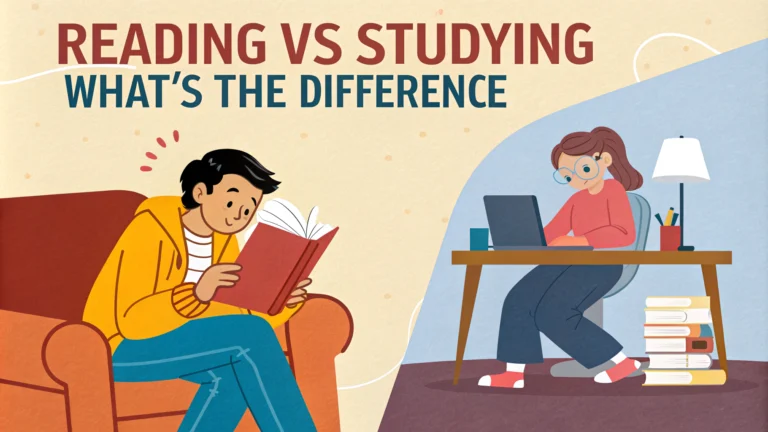Many students mistakenly believe that reading equals studying. Understanding the distinction between **reading** and **studying** can transform your learning approach and improve academic performance.
These two learning methods serve different purposes and require distinct mental processes. While reading is often a passive activity, studying demands active engagement and specific techniques to retain information effectively.
Understanding Active vs Passive Learning Methods
**Active learning** through studying involves deliberate engagement with material through techniques like note-taking, summarizing, and self-testing. **Passive learning** through basic reading typically results in lower retention rates and surface-level understanding.
- Reading: Information flows one way
- Studying: Two-way interaction with material
- Reading: Linear progression
- Studying: Multiple reviews and practice
Essential Reading Techniques for Better Retention
**Strategic reading** approaches like SQ3R (Survey, Question, Read, Recite, Review) help bridge the gap between casual reading and studying. Implementing techniques such as **previewing** and **annotation** transforms simple reading into an active learning experience.
| Basic Reading | Strategic Reading |
|---|---|
| Straight through | Preview and plan |
| No notes | Active annotation |
| Single pass | Multiple passes |
Effective Study Methods and Tools
**Study strategies** should include a mix of techniques tailored to your learning style and subject matter. Incorporate tools like **mind mapping**, **flashcards**, and **practice tests** to enhance information retention and understanding.
“Reading is the basic tool in the living of a good life.” – Mortimer J. Adler
- Spaced repetition systems
- Cornell note-taking method
- Concept mapping
- Practice problem solving
Managing Your Time Between Reading and Study Sessions
Effective **time allocation** between reading and studying requires a balanced approach. Setting specific blocks for each activity helps maintain focus and prevents mental fatigue.
- Schedule reading during high-energy periods
- Break study sessions into 25-minute blocks
- Allow buffer time between activities
- Set clear goals for each session
Tracking Your Learning Progress
**Regular assessment** helps identify gaps in understanding and areas needing more attention. Use **performance metrics** to measure comprehension and retention rates.
| Assessment Method | Purpose |
|---|---|
| Self-quizzing | Quick comprehension check |
| Summary writing | Deep understanding |
| Peer discussion | Knowledge gaps identification |
Common Reading and Study Mistakes
Avoiding these frequent errors improves learning efficiency and information retention.
- Highlighting without purpose
- Skipping breaks between sessions
- Relying on passive re-reading
- Not reviewing notes regularly
“Learning is not attained by chance, it must be sought for with ardor and attended to with diligence.” – Abigail Adams
Combining Reading and Study Methods
Integrate both approaches to create a powerful learning system. Match **reading techniques** with appropriate **study methods** based on the subject matter and learning goals.
Effective Integration Strategy
- Read actively with a study goal in mind
- Create study materials while reading
- Review notes within 24 hours
- Test understanding through practical application
Regular practice of these combined methods leads to better retention and deeper understanding of course material. Focus on building sustainable habits that work for your learning style.
| Reading Phase | Study Action |
|---|---|
| Preview material | Create study questions |
| Main reading | Take structured notes |
| Review | Summarize key points |
Reading vs Studying FAQs
1. What’s the main difference between reading and studying?
Reading is a passive activity involving consuming text, while studying is an active process that includes reading, note-taking, analyzing, and memorizing information for better retention.
2. Is reading textbooks the same as studying them?
No. Reading textbooks is just one component of studying. Effective studying requires active engagement through highlighting, summarizing, and practicing concepts.
3. What are the best techniques to convert reading into active studying?
Key techniques include:
- Taking detailed notes
- Creating mind maps
- Using the SQ3R method (Survey, Question, Read, Recite, Review)
- Teaching concepts to others
- Making flashcards
4. How much more effective is studying compared to just reading?
Research shows active studying leads to 50-75% better retention compared to passive reading alone.
5. Why does casual reading not lead to good exam performance?
Casual reading lacks the critical analysis and repetition needed for long-term memory formation and deep understanding of complex concepts.
6. What’s the ideal ratio between reading and other study activities?
A recommended breakdown is:
| Activity | Time Allocation |
|---|---|
| Reading | 30-40% |
| Note-taking | 20-25% |
| Practice/Problems | 25-30% |
| Review/Recall | 10-15% |
7. How can I improve my reading comprehension for better studying?
Improve comprehension by:
- Reading in shorter chunks
- Summarizing each section
- Creating questions about the material
- Using active recall techniques
8. What’s the best time of day for reading vs studying?
Complex studying is most effective during peak mental alertness (typically morning), while lighter reading can be done during less optimal times.
9. How can I make textbook reading more effective for exam preparation?
Use the PQ4R method: Preview, Question, Read, Reflect, Recite, and Review. This transforms passive reading into active studying.
10. What role does note-taking play in transforming reading into studying?
Note-taking creates an active learning process by engaging multiple senses and forcing information processing, unlike simple reading.
11. How long should I spend reading versus actively studying?
Follow the 50-10 rule: 50 minutes of active studying followed by 10 minutes of break. Pure reading sessions can be longer but are less effective for retention.
12. What are the signs that I’m reading instead of actually studying?
Signs include:
- No notes being taken
- Unable to recall previous pages
- Passive highlighting without processing
- No practice problems attempted



















